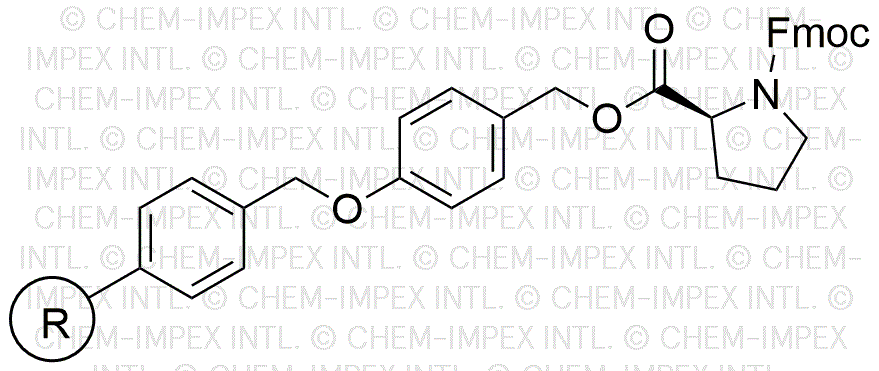Fmoc-L-proline 4-alkoxybenzyl alcohol is widely utilized in research focused on:
- Peptide Synthesis: This compound serves as a protecting group in the synthesis of peptides, allowing for the selective modification of amino acids without interfering with other functional groups.
- Drug Development: It plays a crucial role in the development of pharmaceutical compounds, particularly in creating prodrugs that enhance bioavailability and therapeutic efficacy.
- Bioconjugation: The compound is used in bioconjugation techniques, enabling the attachment of biomolecules to surfaces or other molecules, which is essential in diagnostics and therapeutic applications.
- Material Science: It finds applications in the creation of functionalized polymers and materials, contributing to advancements in drug delivery systems and smart materials.
- Research in Organic Chemistry: Researchers utilize it for studying reaction mechanisms and developing new synthetic methodologies, benefiting from its unique structural properties.
General Information
Properties
Safety and Regulations
Applications
Fmoc-L-proline 4-alkoxybenzyl alcohol is widely utilized in research focused on:
- Peptide Synthesis: This compound serves as a protecting group in the synthesis of peptides, allowing for the selective modification of amino acids without interfering with other functional groups.
- Drug Development: It plays a crucial role in the development of pharmaceutical compounds, particularly in creating prodrugs that enhance bioavailability and therapeutic efficacy.
- Bioconjugation: The compound is used in bioconjugation techniques, enabling the attachment of biomolecules to surfaces or other molecules, which is essential in diagnostics and therapeutic applications.
- Material Science: It finds applications in the creation of functionalized polymers and materials, contributing to advancements in drug delivery systems and smart materials.
- Research in Organic Chemistry: Researchers utilize it for studying reaction mechanisms and developing new synthetic methodologies, benefiting from its unique structural properties.
Documents
Safety Data Sheets (SDS)
The SDS provides comprehensive safety information on handling, storage, and disposal of the product.
Product Specification (PS)
The PS provides a comprehensive breakdown of the product’s properties, including chemical composition, physical state, purity, and storage requirements. It also details acceptable quality ranges and the product's intended applications.
Certificates of Analysis (COA)
Search for Certificates of Analysis (COA) by entering the products Lot Number. Lot and Batch Numbers can be found on a product’s label following the words ‘Lot’ or ‘Batch’.
*Catalog Number
*Lot Number
Certificates Of Origin (COO)
This COO confirms the country where the product was manufactured, and also details the materials and components used in it and whether it is derived from natural, synthetic, or other specific sources. This certificate may be required for customs, trade, and regulatory compliance.
*Catalog Number
*Lot Number
Safety Data Sheets (SDS)
The SDS provides comprehensive safety information on handling, storage, and disposal of the product.
DownloadProduct Specification (PS)
The PS provides a comprehensive breakdown of the product’s properties, including chemical composition, physical state, purity, and storage requirements. It also details acceptable quality ranges and the product's intended applications.
DownloadCertificates of Analysis (COA)
Search for Certificates of Analysis (COA) by entering the products Lot Number. Lot and Batch Numbers can be found on a product’s label following the words ‘Lot’ or ‘Batch’.
*Catalog Number
*Lot Number
Certificates Of Origin (COO)
This COO confirms the country where the product was manufactured, and also details the materials and components used in it and whether it is derived from natural, synthetic, or other specific sources. This certificate may be required for customs, trade, and regulatory compliance.

